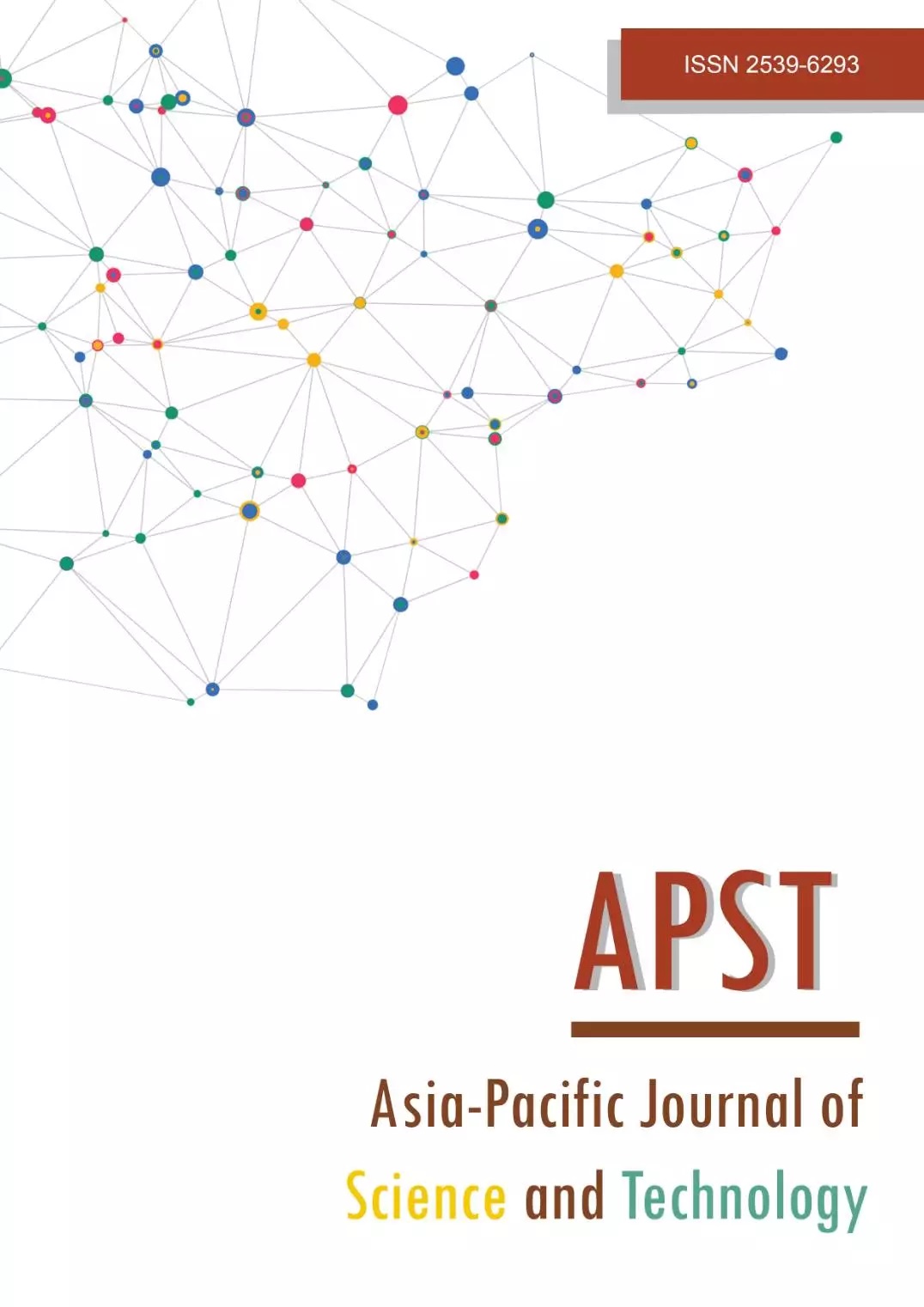Dyeing of screw pine (Pandanus tectorius) leaves using natural dyes from local plants in Songkhla Province, Thailand
Main Article Content
Abstract
This study had investigated and discussed the dyeing of screw pine (Pandanus tectorius) leaves by using natural dyes from four local plants, namely, turmeric rhizomes, as well as teak, mango, and mangosteen leaves, found in Songkhla Province, Thailand. A sample of screw pine leaves were dyed using 2% aluminum potassium sulfate (KAl(SO4)2) for the dye mordanting process, which resulted in good color adhesion. Dyes obtained from turmeric rhizomes, as well as teak, mango, and mangosteen leaves produced yellow, reddish-purple, yellow-green, and orange colors, respectively. The color coordinate of the four dyes was investigated and reported. The tensile properties test showed that the dyed screw pine leaves exhibited good strength. Moreover, ozone treatment was found to decontaminate microbes and enhance the storage stability of the materials. The technology was then transferred to the Screw Pine Handicraft Community in Khlong U-Tapao River Basin, Songkhla Province, Thailand. This transfer of knowledge will enable the community to produce various different dyed screw pine leaf products that would generate a source of sustainable income.
Article Details

This work is licensed under a Creative Commons Attribution-NonCommercial-NoDerivatives 4.0 International License.
References
Nuanlaong P, Inthapantee P. Communication strategies for conveying the cultural wisdom of Krajood wicker product weaving at Ban Huayleuk in Surat Thani province. The Asian Conference on Media, Communication & Film 2019. Official Conference Proceedings. Toshi Center Hotel, Tokyo, Japan
Taha, AS, Salem MZM; Elgat WAAA, Ali HM, Hatamleh AA. Abdel-Salam EM. Assessment of the impact of different treatments on the technological and antifungal properties of papyrus (Cyperus Papyrus L.) Sheets. Materials. 2019;12(4):620.
Sun Y, Liu X. How Design Technology Improves the Sustainability of Intangible Cultural Heritage products: A Practical study on bamboo basketry craft. Sustainability. 2022;14:12058.
Nagendrappa, G, Sir illiam henry perkin: the man and his ‘mauve’. Resonance. 2010;15(9):779–793.
Ayele M, Tesfaye T, Alemu D, Limeneh M, Sithole B. Natural dyeing of cotton fabric with extracts from mango tree: A step towards sustainable dyeing. Sustain Chem Pharm. 2020;(17):100293.
Ogugbue CJ, Sawidis T. Bioremediation and detoxification of synthetic wastewater containing triarylmethane dyes by Aeromonas hydrophila isolated from industrial effluent. A review. Biotechnol Res Int. 2011; 967925.
Thomson LAJ, Englberger L, Guarino L, Thaman RR, Elevitch CR. Pandanus tectorius (pandunus). Spec. Prof. Pac. Isl. Agrofor. 2006;11:1-29.
Englberger L, Schierle J, Hofman, P, Lorens AAK., Lavendusky A, Paul Y, Lickaneth E, Elymore A, Maddison M, deBrum I., Nemra J, Alfred J, Vander Velde N, Kraemer K. Carotenoid and vitamin content of Micronesian atoll foods: Pandanus (Pandanus tectorius) and garlic pear (Crataeva speciosa) fruit. J Food Compost Anal. 2009;22:1-8.
Kareem MW, Habib K, Sopian K, Ruslan MH. Multi-pass solar air heating collector system for drying of screw-pine leaf (Pandanus Tectorius). Renew Energy. 2017
Sonsupab, B, Thanomchat P, Paopun Y. Comparative study on leaf surface of Pandanus tectorius Blume. Among two accessions. Microsc Microanal. 2021;34(1):23-25.
Gupta VK, Jain R, Nayak A, Agarwal S, Shrivastava M. Removal of the hazardous dye tartrazine by photodegradation on titanium dioxide surface. Mater Sci Eng. C 2011;(31):1062-1067.
Kadirvelu K, Kavipriya M, Karthika C, Radhika M, Vennilamani N, Pattabhi S. Utilization of various agricultural wastes for activated carbon preparation and application for the removal of dyes and metal ions from aqueous solutions. Bioresource Technol. 2003;87:129-132.
Basri MSM, Ren BLM, Talib RA, Zakaria R, Kamarudin SH. Novel mangosteen-leaves-based marker ink: Color lightness, viscosity, optimized composition, and microstructural analysis. Polymers. 2021;13:1581.
Ohama P, Tumpat N. Textile dyeing with natural dye from sappan tree (Caesalpinia sappan Linn.) extract. World acad. Eng Technol. 2014;8(5):432-434.
Umbreen S, Ali S, Hussain T, Nawaz R. Dyeing properties of natural dyes extracted from turmeric and their comparison with reactive dyeing. Res J Text Appar. 2008;12(4):1-11.
Stasiak N, Kukula-Koch W, Glowniak K. Modern industrial and pharmacological applications of indigo dye and its derivatives a review. Acta Pol Pharm. 2014;71(2):215-221.
American Society for Testing Materials, “ASTM D 2256-2: Standard test method for tensile properties of yarns by the single-strand method. Annual Book of ASTM Standards, 07.01.
Rosyida A, Suranto S. Use of tectonagrandis leaf extract in colouring silk cloth material based and mordant variations. IOP Conf. ser.: Mater Sci Eng. 2018;333:012051.
Vankar PS, Shuka D. Natural dyeing with anthocyanins from Hibiscus rosa sinensis flowers. J Appl Polym Sci. 2012:3361-3368.
Kumar M, Saurabh V, Tomar M, Hasan M, Changan S, Sasi M, Maheshwari C, Prajapati U, Singh S, Prajapat, RK, Dhumal S, Punia S, Amarowicz R, Mekhemar M. Mango (Mangifera indica L.) leaves: nutritional composition, phytochemical profile, and health-promoting bioactivities. Antioxidants. 2021;10(2):299.
Stavenga DG, Leertouwer HL, Dudek B, van der Kooi C.J. Coloration of flowers by flavonoids and consequences of pH dependent absorption. Front. Plant Sci. 2021;11(100604).


